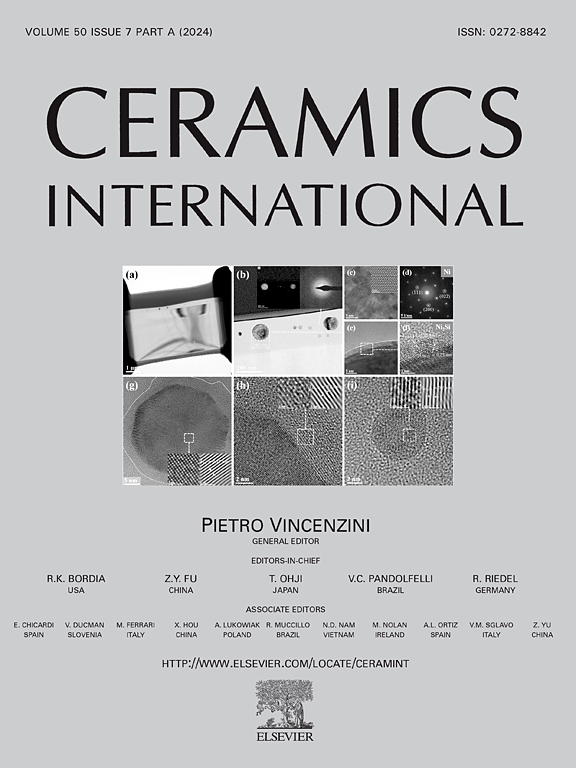Effect of trace (Bi0.5Na0.5)TiO3 doping on PTCR properties of BaTiO3-based thermosensitive ceramics
IF 5.6
2区 材料科学
Q1 MATERIALS SCIENCE, CERAMICS
引用次数: 0
Abstract
BaTiO3-Bi0.5Na0.5TiO3 (BT-BNT) material system has been extensively studied as a lead-free positive temperature coefficient resistance (PTCR) ceramic with a high Curie temperature. Although BNT can increase Curie temperature, it is at the expense of room temperature resistivity. In this study, the effects of trace BNT doping on the crystalline structure, microstructure and PTCR properties of La, Nb and Mn Co-doped BaTiO3 PTCR ceramics were investigated. The results show that with the increase of BNT content, the lattice parameters, tetragonality and grain size decrease, while the Curie temperature increases monotonously. However, the room temperature resistivity decreases at first and then turn over to increase as the BNT content increases, reaching its minimum value at the sample doped with 0.25 mol % BNT. TEM study reveals that Na + ions and Bi3+ ones can be separated at grain boundaries. Bi3+ ions enriched in the grain interior affect the resistivity as donors, while Na+ ions enriched in the grain boundary affect the grain boundary barrier as acceptors. The impedance spectrum analysis proves that the resistivity jump is mainly determined by the grain boundary resistance. The ceramics doped with 0.25⁓0.50 mol% BNT sintered at 1330 °C for 30 min in air have good comprehensive PTCR properties, with room-temperature resistivities of 18.00⁓95.52 Ω cm, resistivity jumps of 1.45 × 103⁓7.45 × 103, and Curie temperatures of 133⁓138 °C. This study provides a new approach for the research of BT-BNT lead-free thermosensitive ceramics.
微量(Bi0.5Na0.5)TiO3掺杂对batio3基热敏陶瓷PTCR性能的影响
BaTiO3-Bi0.5Na0.5TiO3 (BT-BNT)材料体系作为一种具有高居里温度的无铅正温度系数电阻(PTCR)陶瓷得到了广泛的研究。虽然BNT可以提高居里温度,但这是以牺牲室温电阻率为代价的。本文研究了微量BNT掺杂对La、Nb、Mn共掺杂BaTiO3 PTCR陶瓷的晶体结构、微观结构和PTCR性能的影响。结果表明:随着BNT含量的增加,材料的晶格参数、四方性和晶粒尺寸减小,居里温度单调升高;然而,随着BNT含量的增加,室温电阻率先降低后升高,在掺杂0.25 mol % BNT时达到最小值。TEM研究表明,Na +离子和Bi3+离子可以在晶界处分离。晶粒内部富集的Bi3+离子作为供体影响电阻率,晶界富集的Na+离子作为受体影响晶界势垒。阻抗谱分析表明,电阻率跳变主要由晶界电阻决定。掺0.25⁓0.50 mol% BNT的陶瓷在1330℃空气中烧结30 min,具有良好的PTCR综合性能,室温电阻率为18.00⁓95.52 Ω cm,电阻率跳变为1.45 × 103⁓7.45 × 103,居里温度为133⁓138℃。本研究为BT-BNT无铅热敏陶瓷的研究提供了新的途径。
本文章由计算机程序翻译,如有差异,请以英文原文为准。
求助全文
约1分钟内获得全文
求助全文
来源期刊

Ceramics International
工程技术-材料科学:硅酸盐
CiteScore
9.40
自引率
15.40%
发文量
4558
审稿时长
25 days
期刊介绍:
Ceramics International covers the science of advanced ceramic materials. The journal encourages contributions that demonstrate how an understanding of the basic chemical and physical phenomena may direct materials design and stimulate ideas for new or improved processing techniques, in order to obtain materials with desired structural features and properties.
Ceramics International covers oxide and non-oxide ceramics, functional glasses, glass ceramics, amorphous inorganic non-metallic materials (and their combinations with metal and organic materials), in the form of particulates, dense or porous bodies, thin/thick films and laminated, graded and composite structures. Process related topics such as ceramic-ceramic joints or joining ceramics with dissimilar materials, as well as surface finishing and conditioning are also covered. Besides traditional processing techniques, manufacturing routes of interest include innovative procedures benefiting from externally applied stresses, electromagnetic fields and energetic beams, as well as top-down and self-assembly nanotechnology approaches. In addition, the journal welcomes submissions on bio-inspired and bio-enabled materials designs, experimentally validated multi scale modelling and simulation for materials design, and the use of the most advanced chemical and physical characterization techniques of structure, properties and behaviour.
Technologically relevant low-dimensional systems are a particular focus of Ceramics International. These include 0, 1 and 2-D nanomaterials (also covering CNTs, graphene and related materials, and diamond-like carbons), their nanocomposites, as well as nano-hybrids and hierarchical multifunctional nanostructures that might integrate molecular, biological and electronic components.
 求助内容:
求助内容: 应助结果提醒方式:
应助结果提醒方式:


